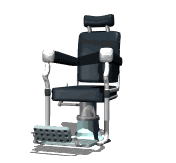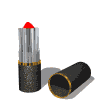| |



Makeup
As far as foundation, concealer, blush, lipstick and the rest are concerned, continue whatever it was that you were doing. It will not only make you feel good, but it will make things seem more normal and routine. The only thing I would recommend doing is to use moisturizing products and products containing sunscreen, particularly during the warmer months when the sun is stronger. Although your skin is susceptible in cloudy weather and all year round.
- Foundation. You can choose a foundation that matches your normal skin tone and a translucent powder to set the foundation. This will also help with dark circles you may notice under your eyes.
- Blush. Use blush to give your face color. Brush upward along the cheekbone. If your face becomes more cumbersome due to weight gain, use a brownish powder. For slimmer faces, a light colored concealer cream will help accentuate certain areas and make them look fuller.
- Eye shadow. Brighten your eyes by using a medium shade across the entire lid, add a lighter color just below the arch of the brow, and then a deeper color in the crease. Blend well to soften the effect.
- Lips. Lip color also helps brighten your face. First, use a soft lip pencil to outline your lips. Aside from keeping your lipstick from bleeding, it also defines your lips and tends to compliment their shape more. Then fill in with a moisturizing lipstick.
- Eyebrows. You can either pencil in new brows or try powder shadows. Powder shadows seem to look a little more natural. You can accomplish this by drawing a soft arch of the brow with eye shadow or powder matching your hair color along the brow bone. Another option is to use waterproof mascara or eye pencil also matching your hair color. Although it may not look as natural, they can be worth trying since some chemotherapy drugs bring on menopause or menopausal symptoms such as hot flashes that will wash away certain powders and pencils. Experiment using both and see which one suits you best.
- Eyelashes. To recreate the look of lashes, you can use liquid liner or eyeliner pencil to draw a thin line along the upper and lower lids. I would avoid applying mascara to any few lashes you may have left since gaps can be quite noticeable in addition to shortening the life of the lashes.
- Fake lashes. You can apply fake lashes if you have the time. Start by drawing a line along the top of your lid with eyeliner. Next, with the adhesive draw another thin line on the lash base (be careful not to apply too much glue). Apply the lashes by using either your fingers or tweezers. Start in the middle and then affix to both sides. After allowing it to dry (try not to blink!) apply another coat of liner over the glue. If your lashes are too long you can cut them with a small pair of scissors. And now you can even apply mascara to them!
As always, immediately report any problems to your oncologist.
One of the most important things you can do to help keep a positive attitude and your self-esteem while going through chemotherapy is to pay attention to your physical beauty. Don’t ever forget how beautiful you truly are.
The American Cancer Society has a program called "Look Good…Feel Better". It offers assistance in things such as makeup and hair specializing in chemotherapy patients. You can contact them at 1-800-395-LOOK or
www.lookgoodfeelbetter.org
Some other websites/articles specializing in makeup are:
www.makeupandbeautyblog.com
Makeup for woman going through chemo
Beauty Tips from Cancer Survivor


Hair
It is reassuring to know that hair loss is temporary. How much, if even at all, and how quickly you lose it all depends upon your chemotherapy drugs. You can talk to your doctor about alternatives to prevent hair loss, but I certainly wouldn’t sacrifice your health for it. The benefits of the drugs strongly outweigh the side effects. Just remember, it will grow back! When it does begin falling out, most likely it will happen fast. The growing process for it to return all depends upon your treatment and the type of drugs that were administered. But generally speaking, your hair will most likely grow back at a rate of about ¼ inch a month.
- Before you lose your hair, consider getting a short haircut. It will help you emotionally as well as having the mess of loose hairs all over the place. When hair falls out, unfortunately it’s not a neat process.
- Some people decide to shave their head once it starts coming out. Whether or not you decide to beat the chemicals to the punch, it’s still your personal decision. Personally, I think it’s a cleaner, neater way of dealing with the inevitable. It also gives you some control over something you don’t have much control over. Everyone opts to do it their own way. You can do it by yourself, have a beautician do it, or make it a family/friend event where everyone can take a chance with the buzzer!
- If you chose to go with the haircut and keep any remaining hairs intact, be gentle to your hair. Continue using mild shampoos and soft brushes.
- Men in general usually turn to hats where women usually choose wigs, scarves, turbans, or hats. It’s a good idea to decide on a wig before you lose your hair so you can match your existing hair color and style. You can choose one that matches what you have or be bold and try something radically different.
- Long haired wigs versus medium haired wigs are a personal choice. But personally, even if you have long hair, I would strongly recommend getting a medium length wig. They’re easier to clean, less of a hassle, and look more natural. Longer haired wigs tend to look more fake.
- Synthetic versus human haired wigs. Both are available, although I would recommend synthetic. It’s easier to take care of, less expensive, and not susceptible to weather (such as humidity) as human hair wigs are.
- Cost. Costs for wigs can widely vary. Although a reasonably priced one will run anywhere from $100-$300. Most insurance companies pay for a "cranial prosthesis" or rather "wig", so be sure to get a prescription from your doctor for one and talk to your insurance company. If not, the "American Cancer Society" and we at the "Mary Stolfa Cancer Foundation" generally have a supply that can be offered. And as stated before, there are other options such as scarves, turbans, and hats.
As always, immediately report any problems to your oncologist.
The American Cancer Society has a program called "Look Good…Feel Better". It offers assistance in things such as makeup and hair specializing in chemotherapy patients. You can contact them at 1-800-395-LOOK or
www.lookgoodfeelbetter.org
Some other websites specializing in wigs are:
www.acewigs.com
www.worldofwigs.com
www.wilshirewigs.com
www.wigsalon.com


Skin Care
- Since treatments can severely dehydrate the skin, it’s imperative to drink lots of water to replenish what your body has lost. Drink about 2 quarts of water daily.
- Avoid activities that will cause you to sweat excessively. You lose moisture from the skin by sweating.
- Pamper your skin. Instead of soap, which can be extremely drying and harsh, try a gentle liquid cleanser such as Nivea, Neutrogena, or Oil of Olay. Avoid strong soaps or heavy oils such as vitamin E because it can trap heat that needs to dissipate within the skin. Any mild soap or creamy cleanser is good. A lot of the time since chemo heightens your sense of smell you may get nauseous from certain odors. So use a non-scented, non-irritating, lightweight moisturizer such as Lubriderm Seriously Sensitive Lotion or Clinique. Water-based products are best.
- Avoid saunas, Jacuzzis, hot baths or showers. Try enjoying cool baths or slightly warm showers and baths. Whenever possible, you can put a little bit of light oil such as safflower or sunflower oil in the water.
- Wear kitchen gloves while doing dishes and warm gloves while outside in the cold.
- Chemotherapy patients are at an increased risk of sunburn so wear protective clothing while outside in the sun. Lightweight cotton pants and shirts as well as silk underwear and pajamas are soothing to the skin. Radiation patients should keep the area being treated well covered. Always wear sunblock (spf 15 or higher) or use products that have sunscreen built into them. Avoid anything with alcohol or retin-a.
- Wash your clothes and other fabrics such as sheets, pillowcases, towels, etc. in mild, hypoallergenic detergent.
- Since your immune system is suppressed, avoid anything that can cause you to run the risk of infection.
- Tattooing or body piercing.
- Acrylic nails, since you’ll be more susceptible to fungus and/or infection. Get a manicure every 1-2 weeks instead. Or, simply use a light colored nail polish to camouflage imperfections. But remember to use only non-acetone based nail polish removers to keep your nails and cuticles from drying out. If your cuticles become extremely dry use solar oil or olive oil. Don’t cut your cuticles! Use lotion to moisturize your hands.
- For acne brought on by chemotherapy, wash your face with mild soaps. Avoid using anything harsh such as astringents.
- Vein darkening or bruises can occur in some patients receiving intravenous chemotherapy infusions. It is temporary, but for some people none the less bothersome. Some patients cover them with long-sleeved shirts while others camouflage them with makeup to make the veins less obvious. Believe me, it is temporary and will fade a couple of months after your last treatment.
As always, immediately report any problems to your oncologist.

Disclaimer: This column is for information only and no part of its contents should be construed as medical advice, diagnosis, recommendation or endorsement by the Mary Stolfa Cancer Foundation.
| About Mary Stolfa | Our Mission | Newsletter | Volunteer | Beauty Parlor | News Articles | Clinical Trials | Other Resources for Cancer Information | Nutrition | Acknowledgement, Awards & Public Acclaim | Foundation Projects | MSCF Products |
| Return Home | Fundraisers | Donations | Wall of Honor | Stories of Hope | Information on Specific Cancers (A-M) | Cancer Issues | Contact Us | Site Index |
|
|











